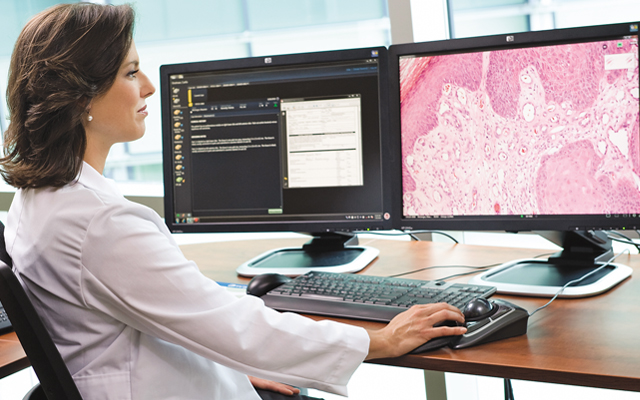Feature Story

Telemedicine used to address rural doctor shortages
October 2, 2014
Communities in rural Canada have long struggled to retain family physicians. Attracting specialist physicians to these areas has been even harder. But in the past year, this troubling trend has begun to change for the better in rural British Columbia with the help of a new telemedicine company, Livecare, and the latest telemedicine technology from AMD Global Telemedicine.
Livecare is a Vancouver-based, physician owned and operated telemedicine company. It was established with the goal of solving the disparity in healthcare access between rural and urban areas. “We know there are issues with patient access to healthcare in Canada,” says Livecare co-founder Dr. Mark Godley. “We have physicians who tend to congregate in urban areas because of hospitals and research opportunities, but a lot of our population is spread across a very large geographical area.”
In 2013, the company’s founders realized the time was right for rural Canada to take advantage of telemedicine. Changes in billing codes meant physicians could now be compensated for conducting live telemedicine exams. What’s more, survey data showed patients were rapidly becoming open to the use of telemedicine, and technological advances from telemedicine companies provided better tools and software than ever before.
“When we began looking for the right technology to execute our vision, we started with videoconferencing solutions. But we soon realized that would not provide the security and privacy a medical application requires,” says Livecare project manager and designer Jahzel Misner. “We then started evaluating purpose-built telemedicine technology and quickly realized AMD Global Telemedicine had the software, devices, security and stability our projects would require.”
Soon after launching Livecare, the pent-up demand for rural medical services was released and projects began to roll in. First, the company partnered with the Clover Care Medical Clinic in Surrey, a location that had faced closures due to over-patient limits. However, they could continue to serve their community by offering after-hours telemedicine consultations that replicated the face-to-face experience. Next, Livecare partnered with community clinics in rural Nelson and Taylor to address the challenge of physician shortages.
“The District of Taylor had actually closed their clinic because they were unable to find a physician to staff it,” says Livecare operations manager Marilyn Lawrie. “We were able to reopen the clinic by staffing it with a nurse trained to use the AMD technology. The nurse connects patients with Vancouver-based family physicians through live telemedicine visits. Now, the clinic is actually open longer and it’s able to accommodate 250-percent more patients than it did when it was staffed with a visiting onsite physician.”
In one of its largest deployments to date, Livecare partnered with the Nisga’a Valley Health Authority to deliver healthcare services to community members in the remote Nisga’a Nation. “Using the AMD software and medical devices, we’re able to connect Nisga’a Nass Valley’s 2,500 community members with family doctors and 52 medical specialists. In many cases, they can see those specialists with shorter waits than patients in urban areas,” says Lawrie. “Through the use of telemedicine, we’ve brought exemplary medical care into a community that was previously bereft of medical care.”
The experience has also been positive for the physicians conducting the telemedicine exams. “Our physicians have noticed many features of the telemedicine technology are actually better than an in-person exam, such as the ability to store images in the secure electronic record and to compare them with new images at a follow-up visit,” says Lawrie. “Many also say the images and sounds produced by the medical devices are better than their traditional medical scopes, cameras and stethoscopes.”
The company’s founders have also been pleasantly surprised by the ease of which telemedicine visits can fit into a standard medical workflow. “When we first started Livecare we thought we would have to completely change the way we did things, but that hasn’t been the case,” says Misner. “With the AGNES software from AMD, we found that we could see a patient the same way we would see them face-to-face – the software really understands live online consultation.”
AMD Global Telemedicine president Steve Normandin says the company is proud to be part of such an innovative telemedicine program. “For more than two decades, our company has realized the potential for telemedicine to bring healthcare to rural and underdeveloped areas around the world. Livecare is a great example of how companies and organizations around the world are using our technology to fulfill that potential – and that’s why we’re so pleased to be part of their incredible effort to provide quality healthcare to rural Canada.”
The founders of Livecare say telemedicine is the future of medical delivery, and the possibilities for its application are limitless. “Telemedicine is a great equalizer that can and will bring medicine to people who wouldn’t otherwise have access to it,” says Godley. “With our vision and the AMD Global Telemedicine technologies, we’ve proven that telemedicine can really work – this is the way medicine will be delivered to remote communities in the future.
Keri Dostie is Director of Marketing at AMD Global Telemedicine, Inc. For more information see: www.amdtelemedicine.com
